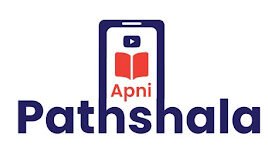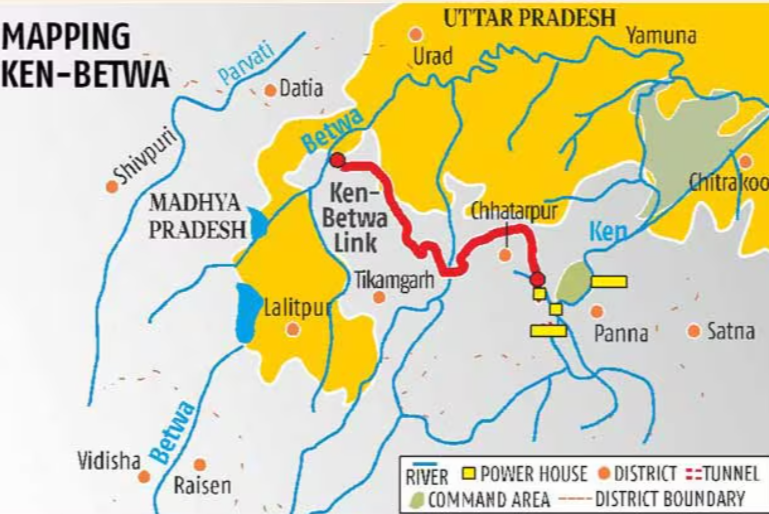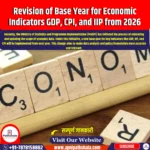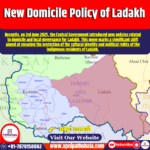Why in News?
Recently, Prime Minister Narendra Modi laid the foundation stone of the Ken-Betwa Link Project (KBLP) in Khajuraho, Madhya Pradesh, on the occasion of the 100th birth anniversary of former Prime Minister Atal Bihari Vajpayee. This landmark initiative aims to address the persistent drought and water scarcity issues in the Bundelkhand region by interlinking rivers to improve water availability.
Introduction of Ken-Betwa Link Project
The Ken-Betwa River Linking Project (KBLP) is India’s first initiative under the National Perspective Plan (NPP) for interlinking rivers. It aims to address water scarcity and irrigation challenges by transferring surplus water from the Ken River in Madhya Pradesh to the Betwa River. The project is crucial for the drought-prone Bundelkhand region, spread across Jhansi, Banda, Lalitpur, and Mahoba districts in Uttar Pradesh and Tikamgarh, Panna, and Chhatarpur districts in Madhya Pradesh.
Key objectives of the project include:
- Providing annual irrigation for over 1 million hectares of agricultural land.
- Enhancing the supply of drinking water to the region.
- Generating approximately 103 MW of hydropower, benefiting both Madhya Pradesh and Uttar Pradesh.
- The project is a significant part of the Indian government’s plan to interlink 30 river basins and construct a 12,500-kilometer canal network.
The Ken-Betwa Project is one of 16 proposed interlinking projects in India and a major step toward addressing water resource management in the country.
Source: https://theearthview.in/indias-first-ever-river-interlinking-project-a-threat-to-tigers/
|
About the National Perspective Plan (NPP)
|
Historical Context and Need for River Linking
The concept of interlinking rivers in India dates back to 1919, when Sir Arthur Cotton, a British irrigation engineer, first proposed it to mitigate droughts and floods. Over time, the idea evolved into a major national initiative, with the Ken-Betwa River Linking Project (KBLP) being one of its flagship components. Key milestones in the history of KBLP include:
- 1960: K.L. Rao, the then Minister for Energy and Irrigation, suggested linking the Ganga and Kaveri rivers to address water imbalances.
- 1982: The National Water Development Agency (NWDA) identified the KBLP as part of its Interlinking of Rivers Plan.
- 1995: A feasibility study for the KBLP was completed by NWDA.
- 2005: A memorandum of understanding (MoU) was signed between Uttar Pradesh, Madhya Pradesh, and the Central Government to prepare a Detailed Project Report (DPR).
- 2008: The project was declared a National Project by the Central Government.
- 2014: The Union Cabinet approved the KBLP, paving the way for its implementation.
- 2021: An agreement was signed between the Ministry of Jal Shakti and the governments of Uttar Pradesh and Madhya Pradesh to execute the project.
Despite its potential, the project faced delays due to environmental concerns and local opposition. Renewed momentum came in 2021, with the government’s approval and funding allocation of ₹44,605 crores in the 2022-23 Union Budget.
Key Features of Ken-Betwa River Linking Project
The Ken-Betwa River Linking Project (KBLP) is planned in two phases and involves significant infrastructure development, including dams, canals, tunnels, and powerhouses.
- Major Components of the Project
-
-
- Daudhan Dam: A 73.80-meter-high dam located on the Ken River near Daudhan village. Dam is equipped with a 326-meter-long side channel spillway on the left flank.
- Ken-Betwa Link Canal: A 231.45 km long canal connecting the Ken and Betwa rivers. This includes a 2 km underground tunnel for efficient water transfer.
- Powerhouses: An underground powerhouse with an installed capacity of 3×20 MW. A surface powerhouse at the tunnel’s exit with a capacity of 2×6 MW.
- Hydropower and Solar Power: The project will generate 103 MW of hydropower and an additional 27 MW of solar power.
-
- Phases of Implementation
-
-
- Phase I: Construction of the Daudhan Dam complex, the Ken-Betwa Link Canal, and power generation facilities.
- Phase II: Development of the Lower Orr Dam, the Bina Complex Project, and the Kotha Barrage.
-
- Administrative and Funding Structure
-
-
- A Ken-Betwa River Link Project Authority will oversee construction and management, including dams, tunnels, and canals.
- The Central Government will bear 90% of the project cost, with the remaining 10% funded by the state governments.
-
- Benefits of the Project
-
- Provides irrigation to over 1 million hectares of farmland in drought-prone regions of Madhya Pradesh and Uttar Pradesh.
- Supplies drinking water to 6.2 million people across districts such as Jhansi, Mahoba, Banda, and Lalitpur in Uttar Pradesh and Panna, Tikamgarh, Chhatarpur, and Sagar in Madhya Pradesh.
- This ambitious project is expected to be completed within 8-9 years.
Rivers Connected Under the Ken-Betwa River Linking Project
- Ken River: The Ken River originates in the Kaimur hills of Madhya Pradesh and flows through the Bundelkhand region before merging with the Yamuna River in Uttar Pradesh’s Banda district. This river is known for its pristine waters and traverses the Panna Tiger Reserve, a critical biodiversity hotspot. The Ken River is a vital water source for agriculture, drinking, and wildlife in the region.
- Betwa River: The Betwa River begins in Raisen district of Madhya Pradesh and flows northwards through the Bundelkhand region, joining the Yamuna River in Uttar Pradesh’s Hamirpur district. Known for its historic significance and utility in irrigation, the Betwa River plays a crucial role in supporting the livelihoods of millions in the area.
Stakeholders Involved in the Ken-Betwa Link Project
The Ken-Betwa Link Project (KBLP) is a multi-faceted initiative involving several stakeholders like central ministries, state governments, and other organizations. Their collective efforts aim to ensure the project’s successful implementation while addressing environmental, social, and technical aspects.
- The Ministry of Jal Shakti is the primary authority overseeing the project. It approved the Ken-Betwa Link Project in December 2021 and is responsible for overall coordination and funding.
- Governments of Madhya Pradesh and Uttar Pradesh: Both state governments play a crucial role in implementing the project. In 2021, they signed a memorandum of agreement with the Ministry of Jal Shakti to collaborate on construction, water-sharing agreements, and ensuring local development.
- Central Water Commission (CWC): The CWC collaborates with the National Water Development Agency (NWDA) on the National Perspective Plan (NPP) for interlinking rivers. It provides techno-economic clearance, ensuring the project is technically viable and economically feasible.
- Ministry of Environment, Forest, and Climate Change (MoEFCC): The MoEFCC is responsible for granting environmental clearance, ensuring that the project complies with environmental laws and minimizes ecological damage, especially in sensitive areas like the Panna Tiger Reserve.
- Central Empowered Committee (CEC): The CEC provides wildlife clearance for the project, addressing concerns about its impact on biodiversity and critical habitats.
- Ministry of Tribal Affairs: This ministry is tasked with preparing a comprehensive Resettlement and Rehabilitation (R&R) plan for tribal populations affected by the project, ensuring their rights and livelihoods are safeguarded.
- Steering Committee: This is chaired by the Secretary of the Ministry of Water Resources, this committee monitors the progress of the project, ensures inter-agency coordination, and resolves any challenges arising during implementation.
- Contractors and Developers: NCC Ltd, the contractor for the Daudhan Dam, is responsible for its planning, design, engineering, and construction. Other developers will be engaged for various components.
Social and Economic Benefits of the Ken-Betwa River Linking Project
- Improved Water Management: The project will contribute to better water management, especially during the monsoon season when excess water can be stored and conserved. This will help maintain steady water supplies during the lean months, particularly in years with inadequate rainfall. The linking of the Ken and Betwa rivers will also facilitate annual irrigation and stabilize hydropower production.
- Agriculture and Irrigation: One of the key benefits of the project is its potential to boost agricultural activities in the Bundelkhand region. The Ken-Betwa Link Canal will provide irrigation to help farmers cultivate crops in areas previously affected by water scarcity. This will increase agricultural productivity and income for local farmers, reducing reliance on erratic rainfall.
- Employment Opportunities: The development of key infrastructure such as dams, canals, and powerhouses will generate significant employment opportunities in construction, operation, and maintenance. Local communities will benefit from jobs in these sectors, thus reducing the need for migration to urban areas.
- Drinking Water Supply: Another major benefit of the project is the enhanced drinking water supply. The Ken-Betwa Link will provide clean water to approximately 62 lakh people across several districts in Uttar Pradesh and Madhya Pradesh, improving public health and quality of life.
- Socio-Economic Prosperity: By improving irrigation, creating employment, and stabilizing water resources, the project will stimulate economic growth in the Bundelkhand region. Agricultural productivity and local industries are expected to thrive, which will promote socio-economic development and reduce the migration of people seeking better living conditions.
- Environmental Considerations: The project is expected to enhance fish and aquaculture activities by improving water levels and promoting sustainable practices in river ecosystems. Moreover, it may also support the creation of bird sanctuaries by ensuring stable water sources in the region, benefiting biodiversity and eco-tourism.
Challenges Surrounding the Ken-Betwa River Linking Project
- Environmental Concerns: The Panna Tiger Reserve, located in Madhya Pradesh, is one of the most critical wildlife areas affected by the project. The construction of dams and canals will lead to deforestation and submerge approximately 98 square kilometers of the reserve.
- The Forest Advisory Committee (FAC) has raised concerns, stating that the project might not align with the long-term interests of wildlife conservation.
- The National Green Tribunal (NGT) has also delayed approvals due to environmental concerns, particularly regarding the potential loss of critical habitats.
- Economic and Financial Challenges: The cost of implementing and maintaining the Ken-Betwa River Linking Project is another major concern. The infrastructure needed for such a large-scale project—such as dams, canals, and powerhouses—requires substantial investment, and any further delays could further escalate costs.
- Social Impact and Displacement: To make way for the construction of dams and reservoirs, thousands of families will be affected, leading to rehabilitation and resettlement challenges.
- Legal and Regulatory Issues: The project also faces legal obstacles. Under the Wildlife Protection Act of 1972, there are restrictions on diverting water from protected wildlife areas. The Supreme Court’s Central Empowered Committee (CEC) has argued that the project may not be “crucial,” given its potential harm to the sanctuary and the violation of environmental norms.
- Rainfall Deficit: A study by IIT Bombay scientists warned that large-scale water diversion for river-linking projects like the Ken-Betwa could result in a rainfall deficit of up to 12% in September, the peak of the monsoon season.
- Impact on Forests and Biodiversity: The project’s completion is expected to submerge about 6,017 hectares of forest land below the Daudhan Dam. It will lead to the loss of valuable flora and fauna. In total, the project will involve the removal of 23 lakh large trees—a significant environmental impact that will alter the landscape and wildlife habitats.
Explore our Books: https://apnipathshala.com/product-category/books/
Explore Our test Series: https://tests.apnipathshala.com/









